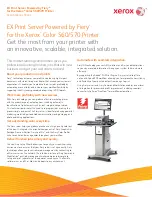
Chapter 2 Handling Paper
2-5
Many envelopes have a diagonal grain orientation (See
Paper
Grain on page 2-3
). This orientation is more likely to wrinkle
and crease on its way through the printer. Before purchasing
envelopes for use with the printer, test a sample to verify the
envelope’s suitability.
Do not use envelopes that have an encapsulated liquid adhe-
sive.
Avoid long printing runs consisting of envelopes only. Exten-
sive envelope printing can cause premature printer wear. To
avoid jamming due to curled envelopes, do not leave more
than approximately 10 printed envelopes stacked in the pa-
per trays during multiple envelope printing.
Colored Paper
Colored paper should satisfy the same conditions as white
bond paper, listed in
1.2Paper Specifications on page 2-1
. In
addition, the pigments used in the paper must be able to with-
stand the heat of fusing during the printing process (up to 200
°C or 392 °F).
Preprinted Paper
Preprinted paper should have a bond paper base. The pre-
printed ink must be able to withstand the heat of fusing dur-
ing the printing process, and must not be affected by silicone
oil.
Do not use paper with any kind of surface treatment, such as
the type of paper commonly used for calendars.
Recycled Paper
Select recycled paper that meets the same specifications as
the white bond paper (see
1.2Paper Specifications on page 2-
1
) except whiteness.
Before purchasing recycled paper, test a sample on the print-
er and check that the print quality is satisfactory.
The printer is capable of printing under the optimum setting
for the type of paper being used.
Setting the paper type for the paper source from the printer’s
operator panel will cause the printer to automatically select
the paper source and print in the mode best suited to that type
of paper.
A different paper type setting can be made for each paper
source including the MP tray. Not only can preset paper types
be selected, but it is also possible for you to define and select
customized paper types. See
Customizing Paper Type on
page 3-46
.
The following types of paper can be set.
Yes: Can be used No: Cannot be used
*This is a paper type defined and registered by the user. Up to eight
types of user settings may be defined. For details on
Customizing
Paper Type on page 3-46
.
NOTE
3. Paper Type
Paper
source
Media
Type
MP
tray
Paper
Cassette
Paper
Weight
Duplex path
(MP tray avail-
able only in
Cassette mode)
Plain
Yes
Yes
Normal 2
Yes
Transparency
Yes
No
Extra
Heavy
No
Preprinted
Yes
Yes
Normal 2
Yes
Labels
Yes
No
Heavy 1
No
Bond
Yes
Yes
Normal 2
Yes
Recycled
Yes
Yes
Normal 2
Yes
Vellum
Yes
No
Light
No
Rough
Yes
Yes
Normal 2
Yes
Letterhead
Yes
Yes
Normal 2
Yes
Color
Yes
Yes
Normal 2
Yes
Prepunched
Yes
Yes
Normal 2
Yes
Envelope
Yes
No
Heavy 1
No
Cardstock
Yes
No
Heavy 2
No
Thick
Yes
No
Heavy 1
No
High quality
Yes
No
Normal 2
Yes
Custom 1
(to 8)*
Yes
Yes
Normal 2
Yes
Table 2-7
Summary of Contents for WP36/50
Page 1: ...1 1 1 Oc WP36 50 Operation Guide Education Services Oc Operation Guide English Version...
Page 12: ...1 1 Chapter 1 Names of Parts A B C D E F 2 3 4 1 0 9 8 7 6 5 H I J L K G Figure 1 1 Figure 1 2...
Page 94: ...Chapter 6 Fonts 6 2 PCL Scalable and Bitmap Fonts...
Page 95: ...Chapter 6 Fonts 6 3 KPDL Fonts 1...
Page 96: ...Chapter 6 Fonts 6 4 KPDL Fonts 2...
Page 115: ......
















































